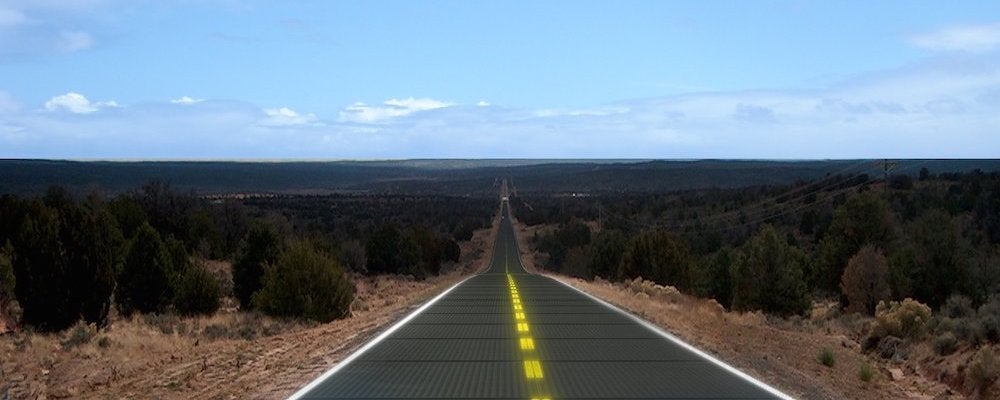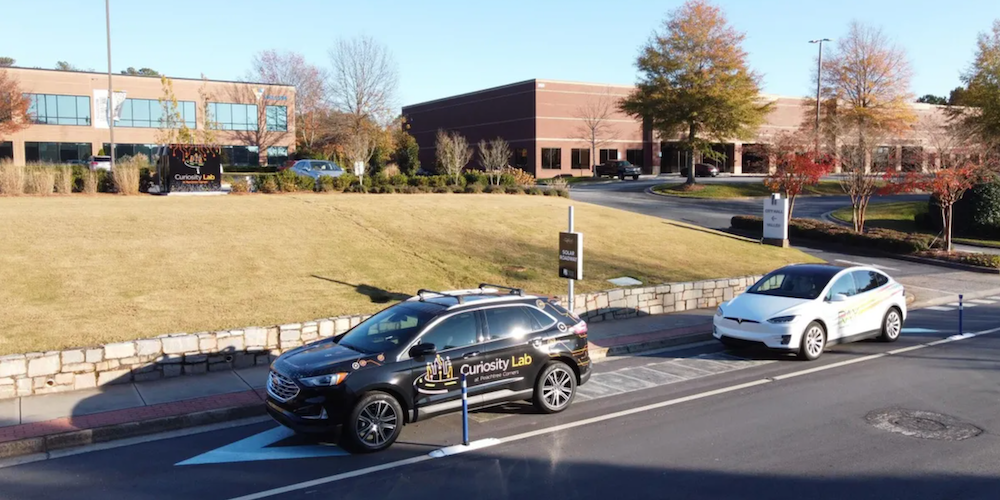Updated 4 months ago
All about Solar Roadways: the promise versus the reality
Written by Zeeshan Hyder Zeeshan HyderZeeshan is a solar journalist who has long been passionate about climate issues and developed a deep interest in solar power after witnessing its succ...Learn more


Why you can trust SolarReviews
SolarReviews is the leading American website for solar panel reviews and solar panel installation companies. Our industry experts have a combined three decades of solar experience and maintain editorial independence for their reviews. No company can pay to alter the reviews or review scores shown on our site. Learn more about SolarReviews and how we make money.
An Idaho-based company conveniently named Solar Roadways has been working on the development of (you guessed it) solar panels-powered roadways.
These solar roadways are driveable highways built with special solar road panels designed to generate enough energy to offer lighting, heating, and other smart features.
Though these special roadways could have the potential to shape the future of solar and renewable energy, the company has run into a few fundamental problems. This article will tell you everything you need to know about this innovative technology.
Key takeaways
Solar Roadways is the name of an Idaho-based company working on the development of an eponymous product: solar roadways.
Solar roadways are highways built with special road panels that can generate solar power and have the potential to offer lighting, heating, and other smart road functionality.
The company Solar Roadways has yet to install an actual solar road installation, while initiatives elsewhere have failed to see success.
Standard solar panels are a much better alternative: they’re a proven technology that can save homeowners tens of thousands of dollars.
Solar Roadways: the promise
Since its founding in 2006, Idaho-based company Solar Roadways has been pushing the endless benefits of its product – most famously in their viral 2014 video, Solar FREAKIN' Roadways. Here's a look at some of them:
The pros of solar roadways (according to Solar Roadways)
Huge energy capacity: According to the company, we could produce three times our annual energy consumption by converting our existing road network into solar roadways.
Safer 'smart' roads: The panels will incorporate LED lights. These can be used to light up dark roads at night and to flash warnings to drivers about obstructions like upcoming roadwork, or a deer crossing the road just around the bend.
Electric car charging: Solar roadways will be able to provide inductive charging – which means that electric vehicles can be charged simply by driving on them.
Usable anywhere: They're not just for roads; they can be installed on any ground-level surface: on parking lots, residential driveways, bike paths, playgrounds...the options are almost endless.
Snow-free surfaces: Solar road panels can incorporate a heating element that can quickly melt off any ice and snow that lands on them. Imagine there's a snowstorm and the road panels immediately melt off the snow off the roads, and even off your driveway – no shoveling required!
Durable and long-lasting: The company claims that road panels will be waterproof and have a lifespan of 20 years – this is longer than the 10 odd years that asphalt roads typically last before needing repairs.
It's a compelling pitch, and it's easy to see why Solar Roadways has generated so much buzz. Solar Roadways has used it to win endorsements from numerous major celebrities, Indiegogo crowdfunding from 50,000 donors, multiple government research grants, and over six million dollars in raised capital, including $2.5 million in a 2021 StartEngine campaign.
It’s worth pointing out here that Solar Roadways Inc, the company, is different from solar roadways, the concept. Some other organizations and initiatives also work with solar road panels and similar products. We'll explore them later.
Solar Roadways: the reality
After successfully generating hype for so many years, what has Solar Roadways achieved so far? And what of the other companies working in this space?
1. Solar Roadways have made no solar roadways
Between 2016 and 2017, news circulated that a Solar Roadways installation on Route 66 in Missouri was in the works. However, the project was not for a roadway at all, but for a solar sidewalk alongside the highway. Whatever the case, the contract fell through (for unspecified reasons) before a single road panel was ever laid.
The only place their product has been used is in their pilot project: a small 150-square-foot installation of walkway in their hometown of Sandpoint, Idaho, installed in 2016. The initial rollout was underwhelming, suffering a fire in its electrical system and then failing to melt snow that fell upon it.
2. There’s one solar roadway in the U.S.
A solar roadway in Peachtree Corners, Georgia is apparently the only one currently operational in the U.S. It was installed in late 2020 using WattWay road panels. However, the project is very limited in scope and occupies a narrow strip within an autonomous vehicle test lane (pictured below). No project data has been shared, so it’s hard to say how it’s performing.

Blink and you’ll miss it: the City of Peachtree Corners’ solar roadway. Image source: Curiosity Lab
3. Projects elsewhere
Solar roadways – and related solar pavement projects like solar bike paths and solar sidewalks – have been trialed in several countries worldwide. While most have been small pilot projects, two larger implementations stand out:
WattWay, France (2016-2019): The first solar road to see real-world conditions was WattWay, a 0.62-mile installation in Normandy, France. It was launched to much fanfare and was accompanied by talk of expanding rollout over 620 miles of French roads. Unfortunately, it generated far less energy than expected and proved unable to withstand the wear and tear of normal traffic, prompting an early closure in 2019. "Our system is not mature [enough] for inter-urban traffic," the company's chief executive concluded.
Solar highway, China (2017-2018): Late 2017 saw the opening of another 0.62-mile solar road, billed the world's first solar highway, in Jinan, China. Unfortunately, it was closed within a week of opening after sustaining damage from traffic and theft (thieves made off with some of the road panels). It's unclear what's become of the project since then.
Here’s a 2018 video released by Chinese state media to promote the launch of the solar highway. There have been no official updates since.
Solar Roadways: the problems
The various solar roadway trials conducted so far have revealed numerous problems, and they’re proving hard to overcome. Here are the biggest concerns:
Solar Roadways cons
High cost: All installation of solar roads completed thus far have been very expensive. The WattWay project in France, for instance, cost $5.2 million for a 0.62-mile stretch of road, or $8.4 million on a per-mile basis. It's estimated that the panels' thick, tough glass surface will cost 3-4 times the price of a standard asphalt road – and that's before accounting for all the other components in a road panel.
Can't handle traffic loads: Engineers have thus far been unable to make a solar road panel that can successfully withstand the pressure of heavy vehicles while remaining transparent enough to let sunlight in.
Low solar power production: Solar roadways produce just one-third the power of solar panels of equivalent capacity in a solar power plant, according to expert engineering analysis. There are several reasons for this:
Less sunlight: Unlike rooftop systems, solar road panels can't be tilted to achieve the best solar panel angle, which means an energy loss of 20% or more.
Shading: They'll also experience shading from passing vehicles, surrounding buildings and vegetation, and debris like dust and leaves. Even a small amount of shade has a major impact on solar panel production.
Excess heat: As they're built into the road, the ground panels can't be cooled by air circulation. This will reduce solar panel efficiency, which drops as panel temperatures exceed optimal levels
Safety and noise concerns: As solar road panels are built with a glass outer surface, this raises doubts about their ability to provide the traction necessary for fast-moving vehicular traffic. In the case of WattWay, the issue was noise. Apparently, vehicles driving over the road surface made so much noise that the speed limit was reduced to 43 miles per hour.
This long list of issues and challenges means that all solar roadway trials so far have yielded disappointing results. Although companies like Solar Roadways and French civil engineering giant Colas (the maker of WattWay) still hope to make it a workable option, that seems unlikely to happen soon – if ever.
The alternative: standard solar panels
There's already an affordable and scalable way to produce renewable energy via the use of standard photovoltaic (PV) solar systems, commonly known as solar panels.
When installed on rooftops (or custom ground-mounts), standard solar panels have long lifespans, high efficiency, and relatively low upfront costs. While the U.S. has only managed to install one solar roadway so far, there are already over three million solar panel installations nationwide.
Solar panels are seeing great success at the utility level. Solar energy plants built with them are now among our cheapest sources of energy production, and total solar capacity is expected to triple between 2022 and 2027.
Solar panels work just as well in homes, where a typical rooftop solar panel installation can cover 100% of energy usage and, depending on the location, save homeowners $50,000 or more in avoided utility bills.
You can learn more about residential solar in this home solar panel guide. Better yet, use the solar calculator below to estimate the costs and savings of installing solar panels on your roof.
Read about other innovative solar technology in the works
Zeeshan is a solar journalist who has long been passionate about climate issues and developed a deep interest in solar power after witnessing its successful adoption in Australia. He has previously worked as a journalist for a major news organization, covering energy, climate, and environmental stories, among other topics. He also served as an organizer for the Pakistan Youth Climate Network, an advocacy group aimed at raising climate awareness...
Learn more about Zeeshan Hyder